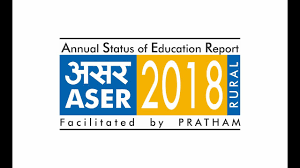The Annual Status of Education, ASER report by the NGO Pratham which measures the learning outcomes has been released. The report was based on an annual household survey which covered 5.46 lakh children in 596 rural districts across the country.

Findings of the ASER 2018 Survey
The important findings from the ASER 2018 survey are:
- For the first time since the introduction of the Right to Education Act, India witnessed tangible improvements in the quality aspects. The study shows that more than half (50.5%) of all children in Class 5 can read a Class 2 textbook, up from 46.9% in 2012.
- The proportion of children in Class 5 who can do simple division has gone up from 24.9% in 2012 to 27.9% in 2018.
- The reading levels of class 3, which was assessed by the ability to read Class 2 textbooks was inching up since the low of 2010 (19.5%) and now stands at 27.2%.
- Government schools in eight states of Himachal Pradesh, Uttar Pradesh, Odisha, Chhattisgarh, Karnataka, Kerala, Mizoram and Arunachal Pradesh have recorded a growth in basic reading levels of more than 5 percentage points over 2016.
- Government schools in 10 states of Punjab, UP, Assam, Chhattisgarh, Maharashtra, Kerala, Tamil Nadu, Nagaland, Mizoram and Arunachal Pradesh have recorded a growth of more than 5 percentage points in basic arithmetic levels 2016.
- Kerala tops in Class 5 reading levels with 77.5%, up from 69.4% in 2016. This growth is driven by state-run schools i.e.10% rise in reading levels in government schools compared to 7.3% in private schools.
- The government schools in Uttar Pradesh have registered an 11.9% jump in reading skills for Class 5 students while private schools saw only a 7.6% rise.
- Wide-disparities among states in learning levels. In Uttar Pradesh, over 60% of Class 3 children cannot recognise letters or read words whereas in Himachal Pradesh over 70% of children are either at grade-level or only close behind.
- 1 out of 4 children in rural India leaves Class 8 without basic reading skills and over half of them (55.9%) without basic numerical literacy or without the ability to do a simple division sum.
- 1% of children in the 15-16 age group are not in school.
- Only a quarter of all children in Class 3 are at their grade-level, only 27.2% of these children can read a Class 2 textbook and only 28.1% can do Class 2-level subtraction.
These sobering realities demand policy interventions. The government must devise a policy direction to address these critical gaps in learning while it formulates the National Education Policy.